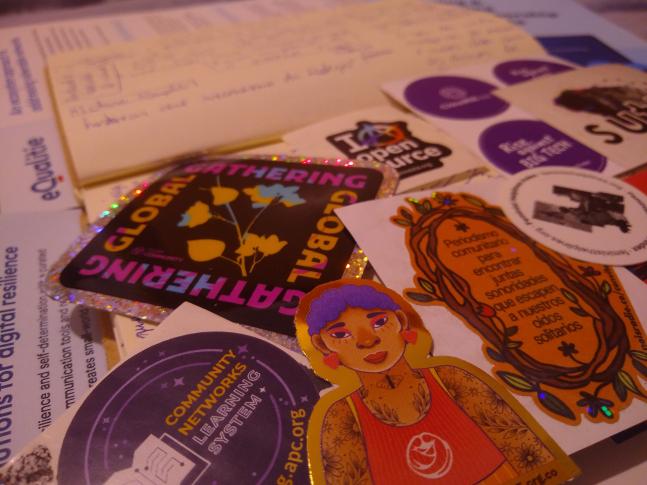
Have you ever been to a craft fair?
Usually there are those little stalls, with each producer showing what they do with care and dedication. People chatting, good food, some music playing now and then, people sitting in the sun talking about life and other philosophies, enjoying the time together.
Now, have you ever thought about digital crafts? I’m not talking about art created by language models. Think about it for a bit, while I go get a coffee and come back…
Thought about it?
Well, this digital craft fair is called the Global Gathering, an event that took place on 8-10 September in Estoril, Portugal, bringing together people from different parts of the world – people who believe in human rights, privacy, security and, above all, that the internet should be a welcoming place for everyone, not just a giant marketplace grabbing our attention and clicks, monetising our habits and emotions.
It was an event that, over three days, hosted discussions and exchanges, from what to do in case of a connectivity breakdown, to the presentation of alternative network forms that don’t necessarily need the internet to exchange messages, but can use it to expand their reach. Conversations about what kinds of spyware are being used to collect privileged information without consent; emotional mapping where maps are reimagined as cartographic tools beyond borders, marking places of connection and safety; and talks about local services where the offline is valued more than the online.
Exchanges about how we’re feeling in Abya Yala, what’s been inspiring and motivating us despite the ongoing suffering (and let’s agree that it’s not just in our region… hello Palestine! and so many other territories facing oppression and violence in the name of intere$t and power).
It was a mix of relaxation and tension, where arms and hugs met. Attention to noticing who was around, and who did or did not have permission to enter the event. It was held in an open but restricted space where exposure could offer safety, but also bring a sense of insecurity because of that very exposure. Where the sun was allowed to shine, warming the conversations, and in each circle the wind carried our voices beyond the fences, reaching places we couldn’t imagine – and let’s be honest, in places where such sensitive topics are discussed, surely those interested in knowing trends and who’s doing what could gain access (as long as they have credentials).
Each little booth, where at a regular craft fair you’d see handmade goods, was instead a showcase of digital craftwork, where each exhibitor could talk about their project, distribute promotional material, connect with those aligned with their purpose and ideals, and inspire possible new projects and ideas for a freer and more accessible internet (could that be a utopia?).
The APC booth, like the others, was a space for exchanges and workshops. We played “The Shutdown Game”, a playful way to explain how the internet works and to think strategically about what alternatives to seek when someone decides to block our path online. A game where the winners are the people – as long as they play together. It’s us against the board.
We had coffee and cake while talking about HERMES, CasaOS and other local services. HERMES stands for High-frequency Emergency and Rural Multimedia Exchange System, and can be used for exchanging media in various formats. It makes use of radio waves that bounce off the stratosphere to carry data inside a “voice suitcase”. In other words, it takes advantage of radio infrastructure to transmit images and text, alternating between voice and bits across long distances. CasaOS was created to make it easier for people to host their own services, thus reducing their dependence on big tech companies. The application is used within communities and is aligned with groups seeking a connected existence based on the “good living” [buen vivir] philosophy. It’s a system capable of hosting many kinds of applications, from document sharing to web radio. In addition to discussing CasaOS, we exchanged ideas about other alternative software with a primarily local focus, used for community organising, territorial protection, and networking in a way that doesn’t rely on the internet.
Between conversations and hugs, this little booth was also a space to present and discuss safety topics, launching the zines Sue companheire não é hacker (“Your partner is not a hacker”). These are two zines created to demystify the myths and legends surrounding the topic of mobile phone hacking, which fill women, trans and queer people with anxiety, paranoia and helplessness in the face of digital violence. The zines provide accessible information so that one can weigh the seriousness of the risk with a realistic approach. There was also a moment to touch on the theme of connected infrastructures for collective survival, from a feminist perspective. Among the notes taken during the session, it was emphasised that such infrastructures must convey a sense of welcome – structures allowed to have errors and failures, to be switched off just like us humans, who need to sleep and disconnect. Structures that break with the logic of infinite availability (24/7) and raise the question of how to balance usability, accessibility and security.
Ahhh… there was so much more that words can’t express, nor images (since we weren’t allowed to take photos there), like freshly ground and pressed coffee, made using manual methods, something so simple in this reality where we’re getting more and more used to buttons and automation (of course, depending on where on the globe [city/countryside] you live). A moment to talk and connect beyond the internet, with people doing similar and dissimilar things, broadening horizons to keep moving forward in strengthening the right to communicate and express ourselves, to be human.
Tania is someone who found, among books, computers and television, imaginative seeds and open windows, expanding horizons and life itself along unimaginable paths.